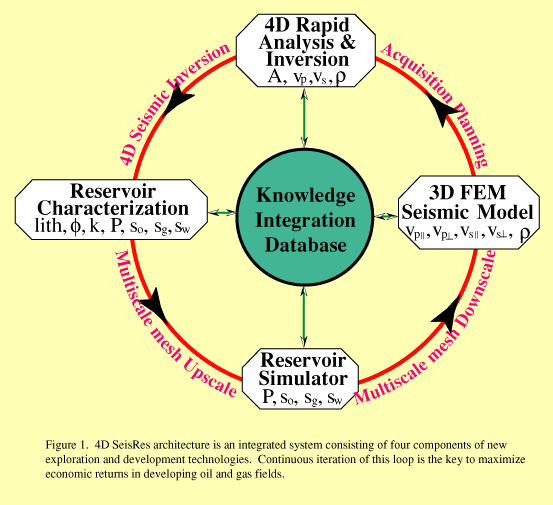
Principal Investigator: Roger N. Anderson
Co-Principal Investigators:
Yu-Chiung Teng, Wei He, Liqing Xu, Albert Boulanger
Lamont-Doherty Earth Observatory
Columbia University
Palisades, New York 10964
and
Ulisses Mello, IBM Watson Research laboratory
Yorktown Heights, New York
Duration: 3 years
Start Date: 1 February, 1997
We will develop a 4D seismic reservoir simulator (4D SeisRes) that couples a) our 4D Rapid Analysis technologies (patented) for analysis of repeated 3D seismic surveys of the subsurface, with b) our 4D Seismic Inversion (patent pending) and stochastic reservoir characterization techniques that describe the physical state of reservoirs at each observational time step. Output is in turn fed into c) a massively parallel reservoir fluid flow simulator to predict the history of fluid flow within reservoirs under study. This fluid flow history is then fed to d) a newly invented code for 3D Finite Element Modeling of wave propagation in anisotropic (transversely isotropic), elastic media (patent application in preparation). The fluid flow predictions are converted in the seismic simulator into expected acoustic responses, which are then tested against a) again to create a constantly updating loop that is the 4D SeisRes monitoring of reservoirs. The loop is constantly iterated so that the system learns the correct fluid flow behavior over time (Figure 1).

| Links rock physics and acoustics. | Offers for the first time integration of all seismic, log and production data with an interlinked set of quantitative models and analysis products to predict reservoir acoustic dynamics. Offers a methodology to link engineering with geophysics. |
| Closes the seismic loop. | Iteration allows for improvements in understanding reservoir structure and dynamics as well as better field planning for sensors and well placement. Makes possible command and control for oil fields. |
| Quantitative approach to reservoir management. | Best practice "TQM" methods can be applied across the board for the first time. |
| Predicts future/past. | 100s of synthetic wells can be placed
Planning for:
|
The development of the 4D SeisRes seismic reservoir simulator allows for the integration of observed changes in acoustic response and modeled behavior of the acoustic effects of the drainage of fluids within elastic reservoirs so that "quality-control-management over time" of the drainage pattern and location of bypassed hydrocarbons (oil and natural gas) relative to pore waters in subsurface reservoirs is possible.
The computational efficiencies of the 4D SeisRes modeling, inversion, differencing, and reservoir characterization codes have made a breakthrough possible in reservoir management, so that the computer capability now exists to predict and reproduce 4D seismic and fluid flow changes observed in oil and gas fields during drainage to the surface.
The 4D SeisRes simulation environment is founded in five technological
tasks:
Task 1. (Wei He, Task manager) A stochastic inversion between
logging (hard data) and 3D seismic observations (soft data) is
the starting point so that a reservoir characterization can be
derived that volumetrically predicts rock physics and fluid parameters
at each volume element of the volume at each time of observation.
Porosity, lithology, compressional and shear velocity, density,
gas, oil and water saturation, and permeability are predicted
at each volume element of a several million element mesh.
Task 2. (Ulisses Mello, Task manager) This static description
of the field at fixed snapshots in time is then "upscaled"
into a coarser parallel reservoir fluid flow simulator that adds
history matching of the production and pressure changes from wells
in the field to predict specific oil/gas/water drainage behavior
over time.
Task 3. (Yu-Chieng Teng, Task manager) The results from
the interactions of the fluid flow simulator are then "downscaled"
again into a several million element mesh of a unique Finite Element
Model that predicts the seismic response over time at each volume
element of the model. The 3D FEM is elastic and fully capable
of simulating waveform response from drainage changes in shear
as well as compressional amplitudes and travel-times. Up to five
independent elastic constants are required to vary among each
volume element over time. A unique tetrahedral discretization
is used to generate the required computational efficiency necessary
to make the model solvable on even the most massively parallel
of supercomputers.
Task 4. (Liqing Xu, Task manager) The predictions of the
seismic model are then compared and differenced with the observed
changes in repeated 3D seismic and other physical properties of
the field using the Lamont 4D Rapid Analysis software.
Task 5. (Albert Boulanger, Task manager) 4D SeisRes "man/machine" workflow to support the computing infrastructure must closely parallel the developments and linkages of the other tasks throughout the project. This task includes the development of a key component to our data centric infrastructure -- a centralized database to act as a common data base for all the other major components of the SeisRes architecture.
4D SeisRes development will be executed in partnership with Western
Atlas International. With Western's support and assistance, we
will also form a new 4D SeisRes Consortium of oil companies to
provide user-guidance and support throughout the duration of the
project. Texaco's Bellaire Research Laboratory has been asked
to be the "prime industry sponsor" as Shell is doing
for the present 4D Seismic Monitoring Consortium.
The techniques used to support this work derived from Patents
for Lamont Rapid Analysis Software and Geopressure Detection,
Patent Applications for 4D Seismic Inversion and 4D SeisRes, and
commercially available technologies related to stochastic reservoir
characterization and reservoir fluid flow simulations--both of
which Western is noted for. No federal funds have gone into the
development of 4D SeisRes itself, however.
The 4D SeisRes simulator will form the first-ever "command-and-control"
environment for hydrocarbon production, allowing oil companies
rapid responses to production problems such as water coning and
providing for the re-direction of assets to effect more favorable
drainage patterns in the subsurface. Higher recovery efficiency
results.
In order to quantify the predicted bypassed hydrocarbon reserves,
we must begin with static descriptions of the rock and fluid physics
at the beginning of production. Subsequent time-lapse images of
the reservoirs are iteratively analyzed to compute changes of
these petrophysical and fluid parameters. Specifically, lithology,
porosity, pore fluid pressure, permeability, and gas/oil/water
saturation must be estimated at each element of the volume under
study. The bridge that connects these physical parameters with
compressional and shear velocity and density is our newly developed
4D seismic inversion technique. A fine-scale reservoir characterization
mesh is required. Because we use time-lapse, 3D seismic datasets
in our 4D SeisRes technology, reservoir characterization is also
required to eliminate the ambiguities introduced from seismic
acquisition and processing side-effects, such as different shooting
directions of the various 3D seismic datasets.
For many years, reservoir characterization has played an essential
role in production stages of hydrocarbon reservoir monitoring.
Reservoir simulations are used by developmental geologists and
reservoir engineers to design exploitation plans to optimize hydrocarbon
production and to maximize the recovery efficiency in oil fields
world-wide. Traditionally, only wireline logging data and well
pressure and production histories are extensively used in reservoir
characterization. The characterized reservoirs are often too smoothly
varying due to the lack of lateral resolution. As 3D seismic technology
has evolved, the spatial resolution of 3D seismic data has greatly
improved the resolution of reservoir characterization, particularly
in lateral resolution. As the integration of seismic and wireline
logging data has evolved, modern reservoir characterization has
become more and more accurate and reliable. As a result, reservoir
heterogeneity and discontinuities have been more extensively revealed,
and development plans designed accordingly to achieve the highest
recovery efficiency possible.
However, static reservoir descriptions of the present state-of-the-art cannot accurately predict dynamic behavior of hydrocarbon reservoirs over time. Time-dependent reservoir characteristics are often not taken into account in the static (time-independent) reservoir characterization.
With our 4D SeisRes reservoir characterization technologies, the static as well as the dynamic reservoir properties are estimated simultaneously. In a geostatistical framework, we distinguish the static properties, such as lithology and porosity (in most of the normally compacted sedimentary rocks), from the dynamic properties, such as pore fluid pressure, gas/oil/water saturation. The separation of these properties results in accuracy and confidence in estimated dynamic properties. Because the repeated 3D seismic surveys provide much more constraints in estimating reservoir dynamic properties (Figure 2). The combination of static reservoir characterization and our new 4D reservoir characterization technologies can be used to achieve much higher economic returns.
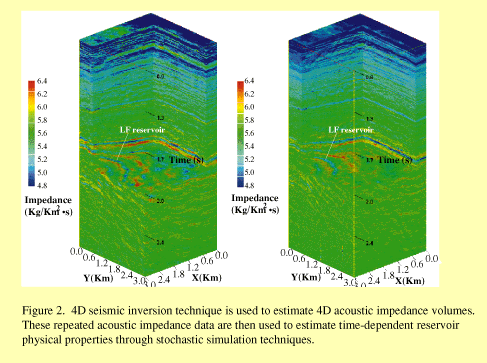
We have invoked a systematic technique to determine reservoir lithologic, porosity, and oil saturation distributions from well logs and 4D seismic data by using a geostatistical approach. Our method consists of a combination of well log data analysis for lithology determination, spatial cross-correlation computations between lithology and acoustic impedance, and a robust stochastic simulation technique. The conditional stochastic simulation technique we used in our study is a Markov-Bayes method.
Steps used in our current 4D SeisRes reservoir characterization are:
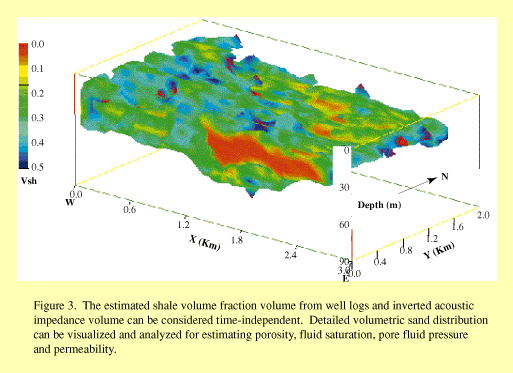
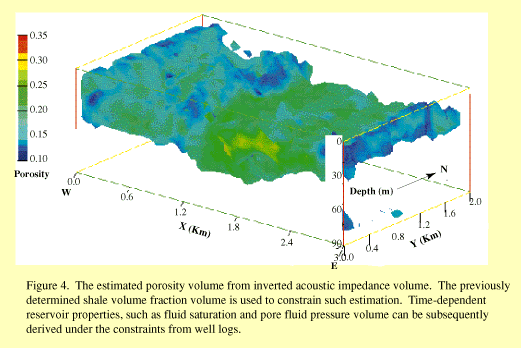
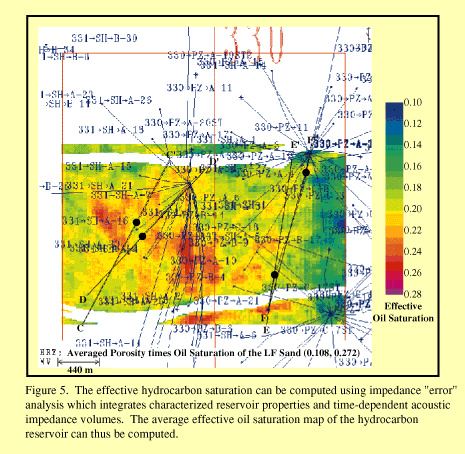
The systematic approach we have implemented above is a sequential method that estimates reservoir properties in a predefined hierarchical order. The order is determined based on the degree of dominance affecting reservoir acoustic properties. It is most useful to delineate time-independent reservoir properties in 3D. The best practice we will be implementing is to use a multi-parameter stochastic simulation technique to estimate all dynamic reservoir properties simultaneously. Such a practice will use the static properties determined previously as masks to constrain the estimation of the dynamic properties in our 4D SeisRes reservoir characterization.
Specifications of our 4D SeisRes reservoir characterization:
We then use the previously generated reservoir characterization as input to a reservoir fluid flow simulator. We currently utilize a commercially available reservoir simulator for the prediction of time-dependent fluid flow required to history match the previous production and pressure behavior of the field.
Upscaling is required to coarsen discretization mesh of reservoir characterization to a reservoir simulator mesh, which typically has a spacing of 10m x 10m x 1m. Because the simulated dynamic reservoir properties has to be converted to elastic parameters in finer scale during the 3D FEM elastic modeling of the SeisRes loop, we will implement at least two meshes simultaneously to constrain the upscale and downscale practices. The coarse mesh is at the resolution of the reservoir simulator, and the finer mesh is at the resolution of regular 3D seismic survey. Characterized static reservoir properties from our reservoir characterization are used as the initial input, the estimated dynamic properties, well test and production data are used to constrain the reservoir simulation. The characteristics derived from our 4D Rapid Analysis will be used as constraints on determining permeability pathways (Figure 6).
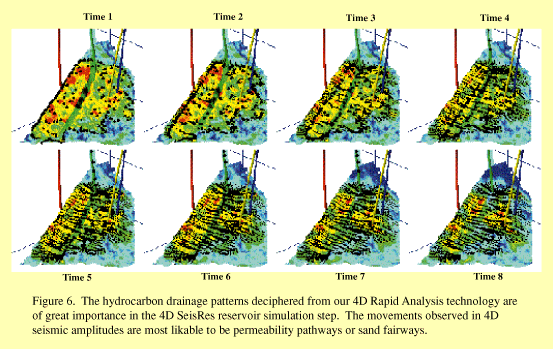
The simulator produces predicted changes in oil/gas/water saturation with time, as well as pressure at each volume element that are then used as input to the 3D seismic FEM. We will use the parallel version of the Landmark's VIP reservoir simulator software, and Ulisses Mello of IBM Watson is in charge of the simulations and the critical upscaling/downscaling grid generation necessary to get into and out of this module.
The meshing and remeshing will be based on the topological information extracted from seismic interpretation and reservoir characterization. Multi-resolution meshes are planned to be used to realize upscale and downscale operations. Meshes and submeshes will be considered as attributes to topological entities representing geological features such as lithology. This approach allows rapid global mesh assemblage and efficient local mesh refining (Figure 7) (Mello and Henderson, 1995).
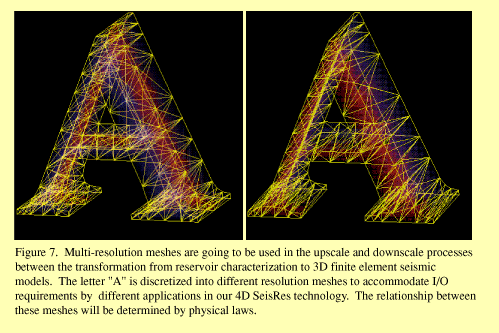
Specifications of our 4D SeisRes reservoir simulation:
Multi-dimensional seismic forward modeling has gradually become a critical tool in seismic exploration for hydrocarbons (Teng et al., 1989; Anderson et al., 1995; and He, 1996). Its importance has been further emphasized as 4-D seismic monitoring techniques have been developed recently, in particular, the realization of FEM seismic model of fractured anisotropic media (Figure 8). 3-D FEM seismic model has not been applied to solve realistic seismic forward problems in the past several decades because of its computation costs. The breakthrough accomplished by Teng et al. (1989 and 1995) has overcome the greatest hurdle in that the computational costs can be significantly reduced. Using modern massively parallel computers, 3D FEM seismic modeling is now feasible.
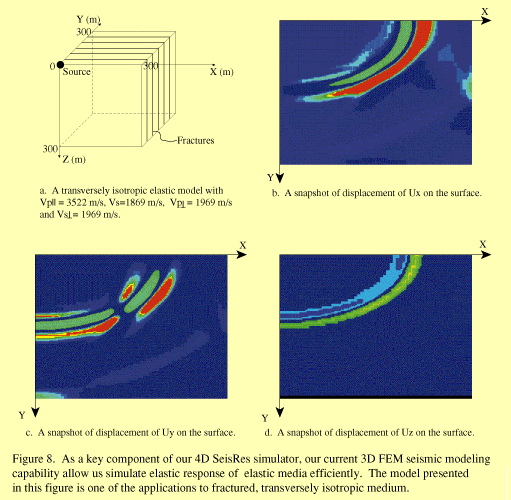
Our computationally efficient algorithms are proven to be accurate and reliable (Figure 9), and we are now confident of predictions of the hydrocarbon drainage patterns using the modeled 3-D seismic data, especially when constrained by 4D analyses of observed seismic changes in an oil field.
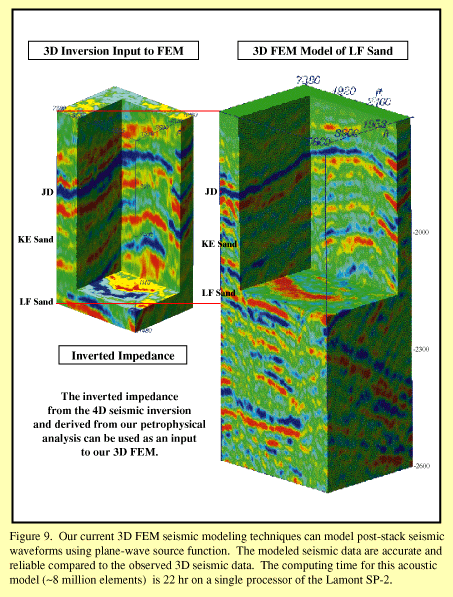
Specifications of the 3D FEM seismic modeling:
The output of the seismic modeling is a set of volumes with changes in seismic amplitude and travel-time predicted at discrete time-intervals over the life of the field. We then difference them with observed changes from the past using the Lamont 4D Rapid Analysis software. The similarities and differences between modeled and real acoustic responses within the reservoirs gives true predictive verification to the accuracy and precision of the model results (Figures 10, 11 and 12). Tools will be developed to use 4D Rapid Analysis of predicted and observed changes to further improve the models (seismic and fluid flow), characterization and 4D inversion thus "closing the seismic loop" Planning for future acquisitions of data, as well as new drilling programs can then be planned based upon the ever-improving model results.

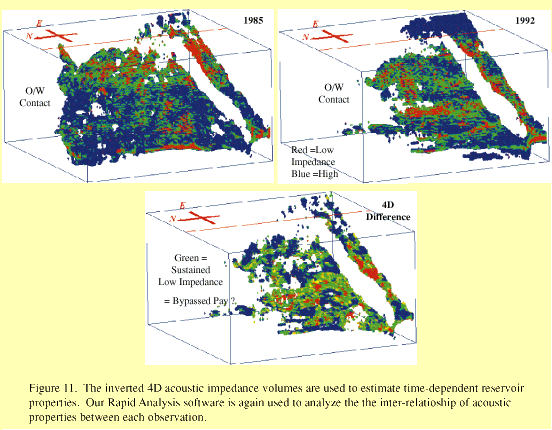
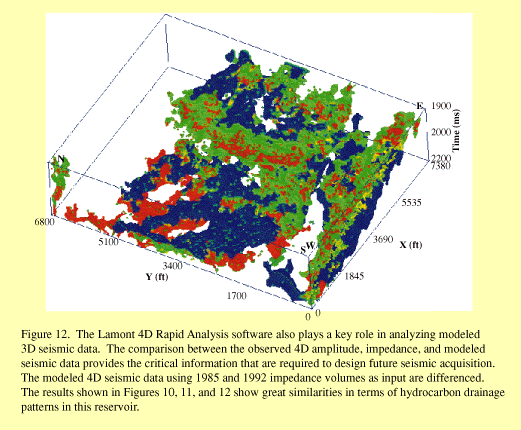
Specifications of the enhanced Lamont 4D Rapid Analysis:
In order for the 4D SeisRes Simulator to become a prime product in reservoir monitoring of oil and gas fields in the future, it will be required to be easily and quickly updated, as frequently as monthly. This means that many of the set-up steps that have been done by hand in the past, such a mesh generation and model geometry definition of the reservoir fluids have to be automated. Many of these automated tools share techniques used to "mine", automatically, very large data sets for potential or bypassed hydrocarbons.
Elements of our automation:
The current utilization of the 4D SeisRes Simulator is being assembled for operation on the Lamont SP-2 center in Palisades, New York. The 3D acoustic FEM is undergoing field tests with real data supplied by oil companies using one node of the SP-2. It runs to completion in about 22 hours. The parallelized elastic extension of this model will utilize all 32 nodes for about the same amount of computing time.
The 4D SeisRes simulator will consume large numbers of parallel supercomputer cycles, and Western has committed to supply the excess over our SP-2 supply. They will be installing a dedicated line from Houston to Palisades, and will allow the Lamont node to operate within their firewall. We will design the architecture of 4D SeisRes so that it can be served securely on the Internet not only through development, but ultimately to oil company consumers.
Imagine our invention as an architecture that understands and
exploits computing cycles on an intranet and the Internet (for
computation split across Western/Lamont or customer.) This infrastructure
will direct execution of modules (via agents) on remote computers
that house the time-dependent seismic datasets and simulation
volumes, and then pipe-along analysis results to other remote
computers that control reservoirs. 4D SeisRes can thus deliver
answers on time for real field decisions. A further step in our
innovation is the integration of diverse computational resources
are "smart pipes" that connect modules that translate
data formats, units, and 3D FEM meshes on the fly. These smart
pipes also enhance the integration of customer programs such as
engineering reservoir simulators into our 4D SeisRes environment.
The rapid turnaround needed for SeisRes requires advanced visualization
methods. Synchronization and control of multiple data streams
are needed as the interpreter interacts in the virtual reservoir
volume. This synchronization is needed since the data coming together
in a common visualization volume will likely come from distributed
databases and computing resources. There will be a need to control
large computations midstream based on preliminary visualization
results. Both of these require the 4D SeisRes AVS execution environment
to support network protocols for synchronization and control-back
of data streams
Complex interacting models and analysis of the scale in SeisRes requires a central data base for storage of results since the interactions among the SeisRes components is not necessarily sequential and a central data exchange/repository is needed. Advanced scientific computing platforms like AVS Express are embracing this data-centric philosophy as well. This repository is likely to consist of a combination of mass storage, relational database incorporating a POSC data model, and persistent object system. This data-centric architecture will function as a data base and knowledge base for Western's petro "best-practices". This task will involve the integration or interfacing to existing Western knowledge- and data-bases relevant to 4D SeisRes.
The 4D SeisRes simulator environment has several technical features that generate value through better managed reservoirs:
Our 4D SeisRes simulator is integrated with the seismic volume from the beginning. We build in acoustic differences between compartments, across sealing faults, between various fluid mixes. The simulation is tested with "pre-drilling", or wells placed to verify the model, then tested to establish the two prime variables to profit: Rates-of-Flow, and Volumetric Extent of the Drainage.
Then a hydrodynamic model of drainage is computed that places injectors at the proper places for maximum return over the life of the field, and delivers the oil and gas much more quickly to the surface than the fractal earth naturally allows.
Consequently, an oil company can place wells to maximize cash-flow
as well as recovery. Not only is peak production exceeded, but
actual volumes produced run several years ahead of conventional
recovery technologies. The 4D SeisRes difference is that with
monitoring in real-time, the simulation can be verified in weeks
rather than in years required for current best-practices of even
the most technologically advanced oil companies.
We envision the oil and gas company of the future to have integrated,
computationally rigorous, control centers for all reservoirs in
all fields. These simulation and control centers will be constantly
updated and recomputed to react to new sensor data coming in from
4D SeisRes surveillance of the field and from instrumented boreholes
and wells that contain pressure, temperature, and acoustic transducers
that detect changes in production activity in the field--in real
time. The 4D SeisRes simulators are parallelized 3-D, FEM's of
three types-- elastic forward and inverse models that interpret
the seismic changes in the field and fluid flow models that predict
the drainage of oil, gas, and water throughout the field. The
models and datasets reside on distributed computational resources
in multiple locations, and both the data and computational cycles
are accessed remotely, and invisibly, by the control operator,
who sees and interacts through a new generation of 3-D virtual
reality visualizers. The 4D SeisRes simulation control operator
calls up windows that display not only the models and datasets,
but the differences and similarities among them over time to maximize
production efficiency in the field.
The analyses combine forward models, inversion, and data fusion. For example, the solution to the 3D anisotropic elastic wave propagation problem involves the combination of going backwards from data to inferred possible models and then forward again to evaluate and eliminate spurious results. Since ill-posed inverse problems have many feasible solutions, a priori and external knowledge of the problem helps to find the most probable models. The tracking of changes in multiple data sets in time will be used to complete the "drainage" picture through "machine-learning".
Interactive visualization and realization is required throughout. A further need for realizing 4D SeisRes production control is the visualization of multiple variables of the integrated 3D datasets -- that is to understand what the acoustic images mean in terms of rock, oil and gas properties while iterations are proceeding. This must be accomplished though interactive visualization of computation as it is proceeding--one must be able to "steer" the models. This will be accomplished by coordinating distributed modeling and analysis over intranets or the Internet with visualization stations as critical focal points along the interpretation tunnel.
Field Control is essential. In the midst of all this computing,
the fact remains that drilling is the ultimate proof-of-concept
and discovery mechanism in oil and gas production. Wells are the
advanced guard of technological proofing in this business. Guidance
to and feedback from wells are indeed a product of and a valuable
resource to the seismic and reservoir modeling and analysis within
the 4D SeisRes simulation environment. The 4D SeisRes consortium
of oil companies will support this function.
If 4D SeisRes technology creates so much value, why hasn't it been widely implemented already to replace the qualitative extraction technology which often relies on the accumulated experience base of engineering teams? A more quantitative approach is clearly desired, but the development of such has been impeded by the disconnect between the virtual (technology) and the physical (oil field) worlds. Organizational factors reflect this technical disconnect:
1) The analysis and computation activities in oil and gas production cover several interacting scales of interest. They require communication between large-scale fluid flow models and small-scale, high-resolution reservoir simulation models that can match the resolution of individual well logs and well production histories. Similarly, seismic processors and interpreters must collaborate more in the correct visualization of subsurface reservoirs. Within the industry, each scale is treated by different specialists -- often in different organizations and with different heritage of faith in computer modeling and analysis. The interactions among the scales, driven often by organizational boundaries, have been consistently information-poor.
2) The computing power necessary to quantitatively couple the seismic scale to the reservoir scale is just becoming available. We are just beginning to assemble a suite of analytical and modeling tools across several organizations that cover all the scales necessary to integrate seismic and well-log data for information-rich and on-time production control.
3) The network-based inter-operations of 4D SeisRes analysis also
pose unique computational challenges. We envisage the development
of an architecture for "lego" models. These models will
be able to describe themselves to each other, and an interface
layer will be able to adapt to a mutually specified set of needs
such as spatial and temporal resolution (auto re-gridding). This
involves the development of network based protocols and a new
orchestration protocol layers that can a) understand the requirements
of the models such as variable mesh geometries among seismic vs.
reservoir simulators vs. fluid flow models, and b) provide interpolation
and unit conversion services between the models. Providing the
concert function as a network service can lead to profound data
exchange bandwidth efficiencies. Providing semantic descriptions
of the Component-Based modules to the orchestration layer can
also allow this layer to migrate modules among different hardware
to load balance, as well as provide security within the project.
Cost, computer cycle and communication effectiveness will result
from the orders-of-magnitude improvement in the scientific understanding
of how fluids drain into wellbores in the subsurface over time.
Evaluation will begin immediately on defining the following design criteria for the 4D SeisRes simulator based upon what Western brings in terms of expertise. (The following tasks are sequential, except that the testing platform and central control center design can be readied while software development occurs):
Task 1: Selection of computational database and decision support environments required.
Task 2: Selection of the decision-support and control-environment.
Task 3: Test installation on which computational platform for testbed development.
Task 4: Schedule for simulation codes to be brought on-line with real-time data acquisition from Alpha test site at supporting oil company.
Anderson, R.N., A. Boulanger, W. He, Y.-F. Sun, L. Xu, and B. Hart, 1995, 4-D seismic monitoring of drainage in the Eugene Island 330 Field in the offshore Gulf of Mexico: in P.Weimer and T.L. Davis, eds., AAPG Studies in Geology No. 32 and SEG Geophysical Developments Series No. 5, AAPG/SEG, Tulsa, 1996, p. 9-20.
He, W., 1996, 4D seismic monitoring of hydrocarbon drainage and geopressure prediction in the Gulf of Mexico Basin, Ph.D dissertation of Columbia University.
Mello, U.T. and M.E. Henderson, 1995, Techniques for including large deformations associated with salt and non-vertical fault motion in modeling, submitted to Marine and Petroleum Geology.
Teng, Y.-C., 1989, Three-dimensional finite element analysis of waves in an acoustic medium with inclusion: Journal of Acoustic Society of America, v. 86, p. 414-422.
Teng, Y.-C. and Y.-F. Sun, 1996, Three dimensional finite element
modeling of wave propagation in anisotropic media, in the proceedings
of the 2nd International Conference on Theoretical and Computational
Acoustics, Honolulu, Hawaii.